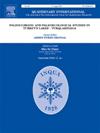Abandonment and population fluctuations of prehistoric villages: Focusing on the Geum River Basin during Korea's Bronze Age
IF 1.8
3区 地球科学
Q3 GEOGRAPHY, PHYSICAL
引用次数: 0
Abstract
This study examines population fluctuations in the Geum River basin during the Early and Middle Bronze Age through settlement distributions, changes in the number of settlements and dwellings, and SPDs of radiocarbon dates. Despite broadly shared material culture during the Bronze Age, demographic patterns varied significantly across four subregions—Miho, upper, middle, and lower Geum River—largely influenced by local topography. In the Miho and upper Geum Rivers, limited settlement space constrained population growth. In contrast, the middle Geum River allowed for settlement expansion and in-migration, but this eventually triggered environmental and social stress, leading to abandonment at the end of Early Bronze Age. The resulting dispersal appears to have contributed to population reorganization in the lower Geum River during the Middle Bronze Age. In this period, changes in subsistence strategies and social structure fostered the emergence of large-scale settlements, sustained in part by group ritual practices.
史前村落的废弃与人口波动——以韩国青铜器时代的锦江流域为中心
本研究通过聚落分布、聚落和住宅数量的变化以及放射性碳测年的spd,考察了青铜器时代早期和中期锦江流域的人口波动。尽管青铜器时代的物质文化广泛共享,但人口分布模式在四个次区域(miho、上、中、下锦江)之间存在显著差异,这在很大程度上受当地地形的影响。在米豪河和锦江上游,有限的居住空间限制了人口的增长。相比之下,锦江中游允许定居点扩张和移民,但这最终引发了环境和社会压力,导致了早期青铜时代末期的遗弃。由此产生的分散似乎对青铜时代中期锦江下游地区的人口重组做出了贡献。在这一时期,生存策略和社会结构的变化促进了大规模定居点的出现,部分是由群体仪式实践维持的。
本文章由计算机程序翻译,如有差异,请以英文原文为准。
求助全文
约1分钟内获得全文
求助全文
来源期刊

Quaternary International
地学-地球科学综合
CiteScore
5.60
自引率
4.50%
发文量
336
审稿时长
3 months
期刊介绍:
Quaternary International is the official journal of the International Union for Quaternary Research. The objectives are to publish a high quality scientific journal under the auspices of the premier Quaternary association that reflects the interdisciplinary nature of INQUA and records recent advances in Quaternary science that appeal to a wide audience.
This series will encompass all the full spectrum of the physical and natural sciences that are commonly employed in solving Quaternary problems. The policy is to publish peer refereed collected research papers from symposia, workshops and meetings sponsored by INQUA. In addition, other organizations may request publication of their collected works pertaining to the Quaternary.
 求助内容:
求助内容: 应助结果提醒方式:
应助结果提醒方式:


